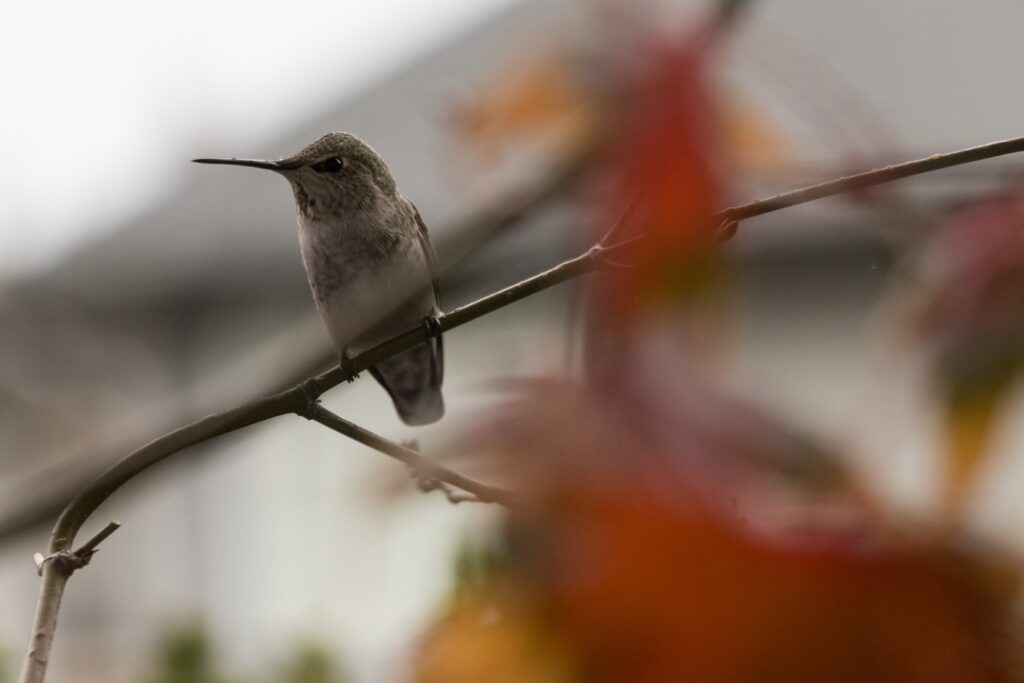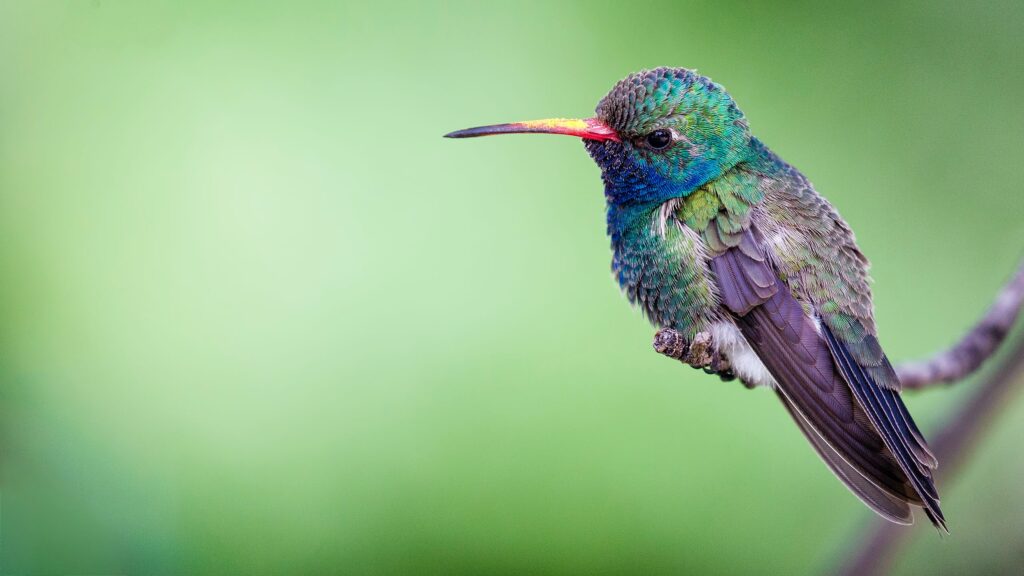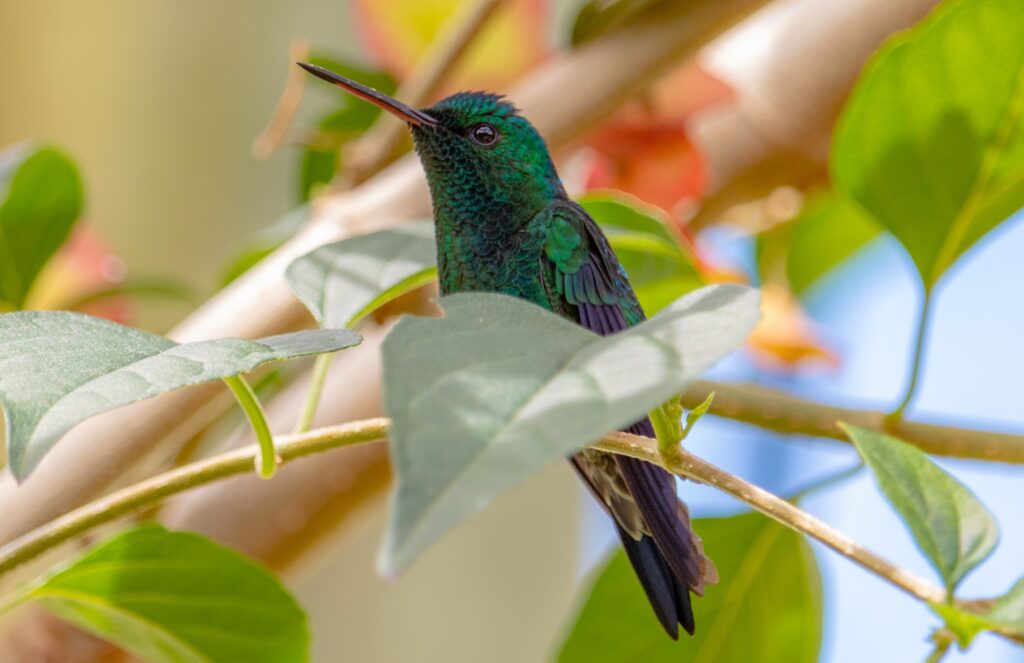Hummingbirds, renowned for their dazzling plumage and swift wingbeats, captivate bird lovers everywhere.
A question often piques curiosity: “Where do hummingbirds sleep?”
This exploration into their nocturnal routines offers insights into where these miniature avians find rest after their energetic days.

Hummingbirds’ Unique Sleeping Habits
As the evening sky dims, hummingbirds commence their quest for a nighttime retreat. Preferring to sleep soon after dusk and wake at the break of dawn, these birds are meticulous in selecting their resting spots.
They often seek out thick, leafy branches that offer both seclusion and protection from predators and the elements.
During their sleep, hummingbirds experience a state called torpor, a deep, hibernation-like state where their metabolic rate plummets, conserving much-needed energy.
In this state, their body temperature and heart rate drop significantly. Without this adaptation, the hummingbird’s high metabolism would cause it starve at night.
One interesting fact is that while in the state of torpor, hummingbirds will even sometimes hang upside down!
Hummingbirds’ Nocturnal Nests
Hummingbirds are solitary when it comes to their sleeping habits, differing from many bird species that roost in groups. The only exception to this rule is that mother hummingbirds will sleep with their eggs or nestlings in her nest.
But they typically find a lone branch in a tree or a dense shrub, which provides safety from predators and harsh weather conditions.
Their chosen perches are usually situated between 5 to 20 feet off the ground, depending on the surroundings and the availability of safe, sheltered spots.
Proximity to food sources is also a critical factor in their choice of sleeping location, allowing them to quickly access nourishment at dawn to replenish their energy stores.

The Safety Aspect
Hummingbirds, known for their agility and speed, adopt several strategies to ensure safety while sleeping. Their choice of sleeping locations is a critical factor in their survival, balancing the need for protection from predators and harsh weather conditions.
- Sleeping in Dense Vegetation: Hummingbirds generally sleep surrounded by dense vegetation. This provides crucial protection from wind, cold, and rain, helping them maintain a consistent body temperature and conserve energy. Such dense vegetation also acts as a barrier against predators.
- Perching on Small Twigs: Hummingbirds often choose to perch on small twigs for sleep. The twig’s shaking helps them detect approaching predators, thus acting as an early warning system. This strategy, combined with dense, sheltered vegetation, offers dual protection from predators and the elements.
- Adaptations in Different Habitats: In varied habitats, such as the high Andes, some hummingbirds might sleep in small caves or crevices in rocks, which provide shelter and safety. Regardless of their location, whether breeding, migrating, or in wintering grounds, hummingbirds consistently seek out dense vegetation or other sheltered spots for sleep.
- Weather and Predator Threats: The main threats to sleeping hummingbirds are nocturnal predators and the elements. The birds’ small size and high metabolism make them particularly vulnerable to cold weather, rain, and wind. Their sleeping habits and locations are thus tailored to mitigate these risks, with protection from the elements being a primary concern.
Impact of Seasonal Changes
The resting habits of hummingbirds are significantly influenced by seasonal changes, exemplifying their adaptability to diverse environments.
During migration, these birds may transition from sleeping in leafy deciduous trees of temperate zones to finding rest in the cacti of arid regions or the dense canopies of tropical forests.
For instance, a Ruby-throated Hummingbird, which spends summers in North America, might choose the protective branches of oak trees at home but opt for the shelter of tropical fig trees or amidst the foliage of mangroves when wintering in Central America.
This flexibility in choosing different types of sleeping habitats, depending on the season and location, underscores their remarkable ability to adjust to varying ecological conditions.

Bullet Point Summary
- Hummingbirds begin their sleep soon after dusk and wake up at sunrise, typically choosing leafy, secluded branches for rest.
- They enter a state of torpor during sleep, significantly lowering their metabolic rate and body temperature and sometimes even hanging upside down!
- Hummingbirds are solitary sleepers, preferring perches in trees or dense shrubs, typically 5 to 20 feet off the ground.
- Safety from predators and harsh weather conditions is a crucial factor in their choice of sleeping spots.
- During migration, hummingbirds adapt their sleeping habits to different habitats and may sleep in more tropical trees or areas with denser foliage in warmer climates.
Conclusion
In exploring the question “Where do hummingbirds sleep?”, we delve into an intriguing facet of their existence. These vibrant, agile birds seek peace in the serene, hidden branches of trees and shrubs. Appreciating their sleep rituals deepens our understanding and admiration for these extraordinary creatures and their adaptability to the natural world.
Also, if you’re looking to attract these delightful visitors to your garden and observe their dynamic flight up close, be sure to check out our article, “Best Placement for Hummingbird Feeders.” It offers valuable insights to create the perfect oasis for hummingbirds, ensuring that as night descends, they might just choose your garden for their secluded perches and a deserved night’s rest. 🌙🐦💤

